Evaluating HRM: Performance Measurement Options for CERA's Development
VerifiedAdded on 2023/06/11
|13
|3001
|109
Report
AI Summary
This report provides a detailed analysis of performance measurement practices at Civil Engineering & Research Associates (CERA), focusing on its Human Resource Management (HRM) strategies. It examines the existing Performance Planning & Review (PPR) scheme, highlighting its limitations in distinguishing extraordinary performers and addressing employee motivation. The report explores the significance of effective performance measurement in organizational development, including employee retention, engagement, and fostering a healthy work culture. It identifies weaknesses in CERA's current practices, such as the lack of feedback mechanisms and perceived unfair compensation strategies. Contemporary developments in HRM are discussed, emphasizing the shift towards people asset management and strategic HRM roles. Finally, the report offers recommendations for CERA, including implementing a 360-degree performance appraisal process and providing regular feedback to employees to improve performance and motivation. Students can find this and other solved assignments on Desklib.
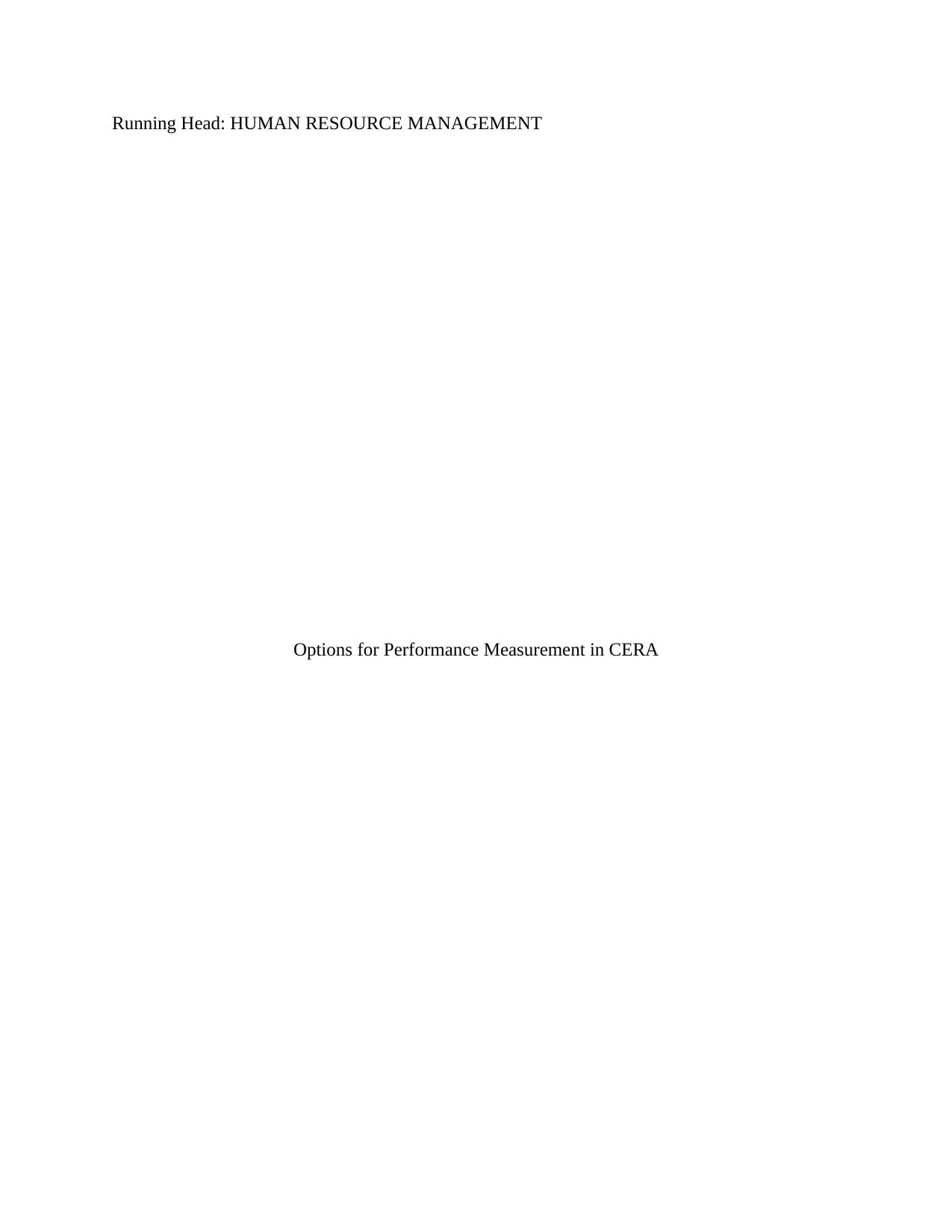
Running Head: HUMAN RESOURCE MANAGEMENT
Options for Performance Measurement in CERA
Options for Performance Measurement in CERA
Paraphrase This Document
Need a fresh take? Get an instant paraphrase of this document with our AI Paraphraser
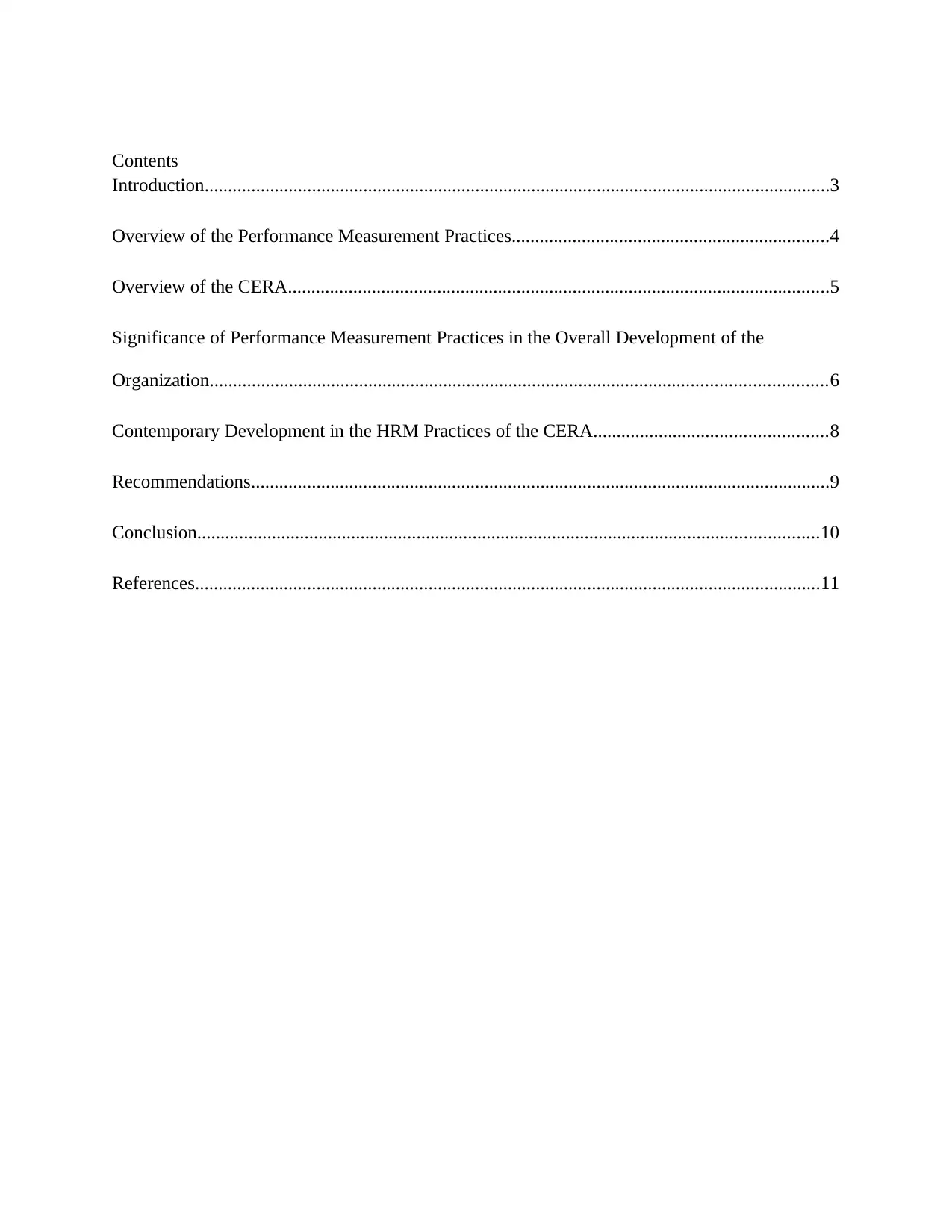
Contents
Introduction......................................................................................................................................3
Overview of the Performance Measurement Practices....................................................................4
Overview of the CERA....................................................................................................................5
Significance of Performance Measurement Practices in the Overall Development of the
Organization....................................................................................................................................6
Contemporary Development in the HRM Practices of the CERA..................................................8
Recommendations............................................................................................................................9
Conclusion.....................................................................................................................................10
References......................................................................................................................................11
Introduction......................................................................................................................................3
Overview of the Performance Measurement Practices....................................................................4
Overview of the CERA....................................................................................................................5
Significance of Performance Measurement Practices in the Overall Development of the
Organization....................................................................................................................................6
Contemporary Development in the HRM Practices of the CERA..................................................8
Recommendations............................................................................................................................9
Conclusion.....................................................................................................................................10
References......................................................................................................................................11
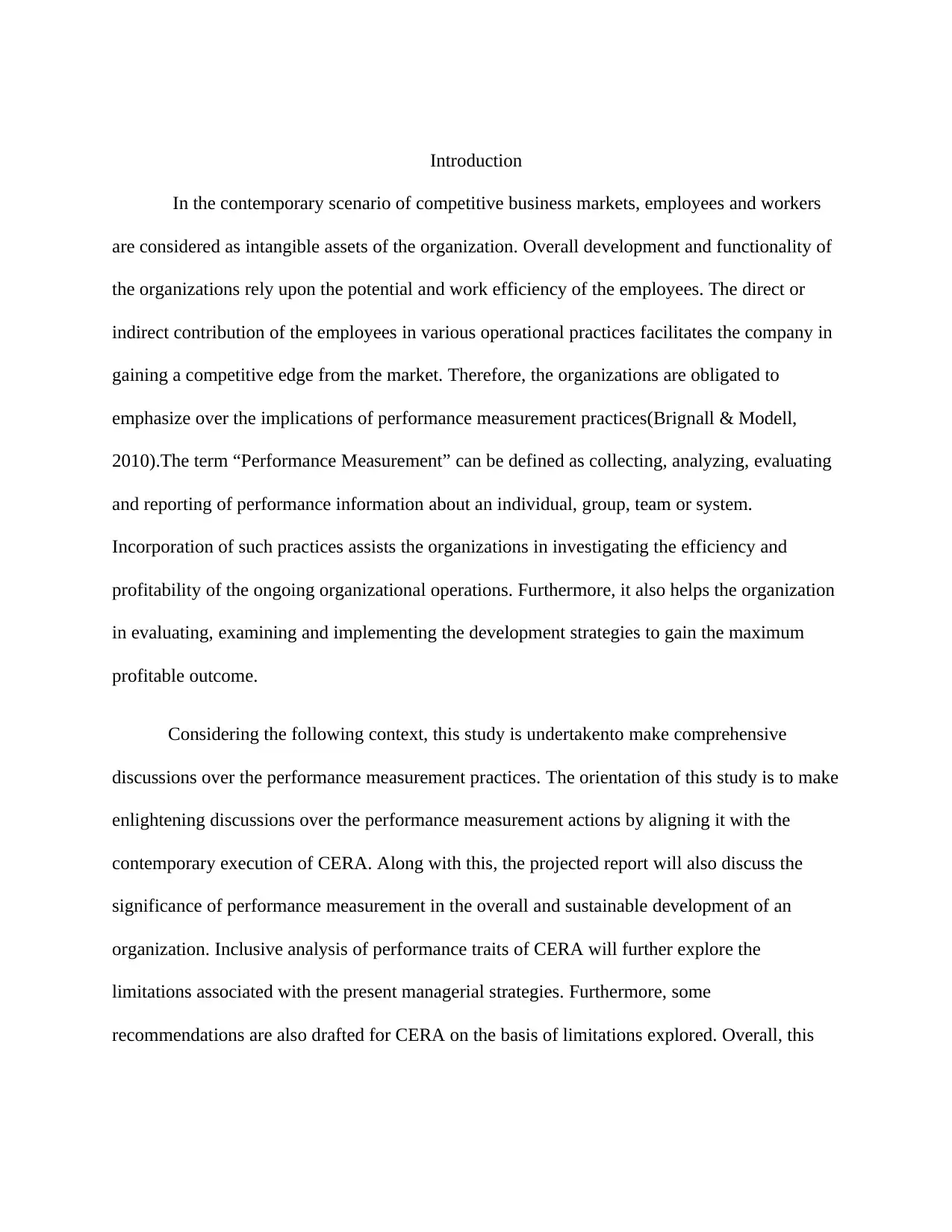
Introduction
In the contemporary scenario of competitive business markets, employees and workers
are considered as intangible assets of the organization. Overall development and functionality of
the organizations rely upon the potential and work efficiency of the employees. The direct or
indirect contribution of the employees in various operational practices facilitates the company in
gaining a competitive edge from the market. Therefore, the organizations are obligated to
emphasize over the implications of performance measurement practices(Brignall & Modell,
2010).The term “Performance Measurement” can be defined as collecting, analyzing, evaluating
and reporting of performance information about an individual, group, team or system.
Incorporation of such practices assists the organizations in investigating the efficiency and
profitability of the ongoing organizational operations. Furthermore, it also helps the organization
in evaluating, examining and implementing the development strategies to gain the maximum
profitable outcome.
Considering the following context, this study is undertakento make comprehensive
discussions over the performance measurement practices. The orientation of this study is to make
enlightening discussions over the performance measurement actions by aligning it with the
contemporary execution of CERA. Along with this, the projected report will also discuss the
significance of performance measurement in the overall and sustainable development of an
organization. Inclusive analysis of performance traits of CERA will further explore the
limitations associated with the present managerial strategies. Furthermore, some
recommendations are also drafted for CERA on the basis of limitations explored. Overall, this
In the contemporary scenario of competitive business markets, employees and workers
are considered as intangible assets of the organization. Overall development and functionality of
the organizations rely upon the potential and work efficiency of the employees. The direct or
indirect contribution of the employees in various operational practices facilitates the company in
gaining a competitive edge from the market. Therefore, the organizations are obligated to
emphasize over the implications of performance measurement practices(Brignall & Modell,
2010).The term “Performance Measurement” can be defined as collecting, analyzing, evaluating
and reporting of performance information about an individual, group, team or system.
Incorporation of such practices assists the organizations in investigating the efficiency and
profitability of the ongoing organizational operations. Furthermore, it also helps the organization
in evaluating, examining and implementing the development strategies to gain the maximum
profitable outcome.
Considering the following context, this study is undertakento make comprehensive
discussions over the performance measurement practices. The orientation of this study is to make
enlightening discussions over the performance measurement actions by aligning it with the
contemporary execution of CERA. Along with this, the projected report will also discuss the
significance of performance measurement in the overall and sustainable development of an
organization. Inclusive analysis of performance traits of CERA will further explore the
limitations associated with the present managerial strategies. Furthermore, some
recommendations are also drafted for CERA on the basis of limitations explored. Overall, this
⊘ This is a preview!⊘
Do you want full access?
Subscribe today to unlock all pages.

Trusted by 1+ million students worldwide
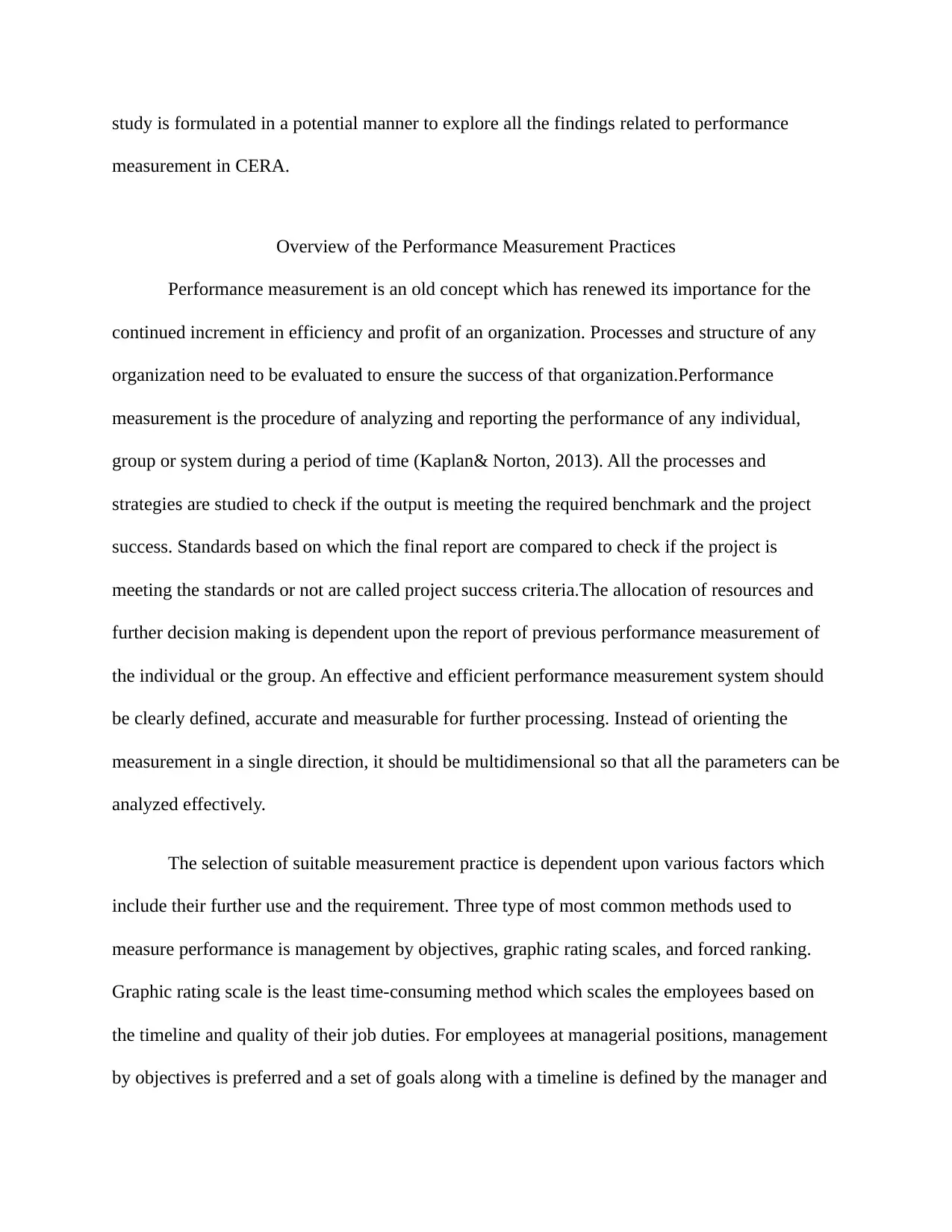
study is formulated in a potential manner to explore all the findings related to performance
measurement in CERA.
Overview of the Performance Measurement Practices
Performance measurement is an old concept which has renewed its importance for the
continued increment in efficiency and profit of an organization. Processes and structure of any
organization need to be evaluated to ensure the success of that organization.Performance
measurement is the procedure of analyzing and reporting the performance of any individual,
group or system during a period of time (Kaplan& Norton, 2013). All the processes and
strategies are studied to check if the output is meeting the required benchmark and the project
success. Standards based on which the final report are compared to check if the project is
meeting the standards or not are called project success criteria.The allocation of resources and
further decision making is dependent upon the report of previous performance measurement of
the individual or the group. An effective and efficient performance measurement system should
be clearly defined, accurate and measurable for further processing. Instead of orienting the
measurement in a single direction, it should be multidimensional so that all the parameters can be
analyzed effectively.
The selection of suitable measurement practice is dependent upon various factors which
include their further use and the requirement. Three type of most common methods used to
measure performance is management by objectives, graphic rating scales, and forced ranking.
Graphic rating scale is the least time-consuming method which scales the employees based on
the timeline and quality of their job duties. For employees at managerial positions, management
by objectives is preferred and a set of goals along with a timeline is defined by the manager and
measurement in CERA.
Overview of the Performance Measurement Practices
Performance measurement is an old concept which has renewed its importance for the
continued increment in efficiency and profit of an organization. Processes and structure of any
organization need to be evaluated to ensure the success of that organization.Performance
measurement is the procedure of analyzing and reporting the performance of any individual,
group or system during a period of time (Kaplan& Norton, 2013). All the processes and
strategies are studied to check if the output is meeting the required benchmark and the project
success. Standards based on which the final report are compared to check if the project is
meeting the standards or not are called project success criteria.The allocation of resources and
further decision making is dependent upon the report of previous performance measurement of
the individual or the group. An effective and efficient performance measurement system should
be clearly defined, accurate and measurable for further processing. Instead of orienting the
measurement in a single direction, it should be multidimensional so that all the parameters can be
analyzed effectively.
The selection of suitable measurement practice is dependent upon various factors which
include their further use and the requirement. Three type of most common methods used to
measure performance is management by objectives, graphic rating scales, and forced ranking.
Graphic rating scale is the least time-consuming method which scales the employees based on
the timeline and quality of their job duties. For employees at managerial positions, management
by objectives is preferred and a set of goals along with a timeline is defined by the manager and
Paraphrase This Document
Need a fresh take? Get an instant paraphrase of this document with our AI Paraphraser
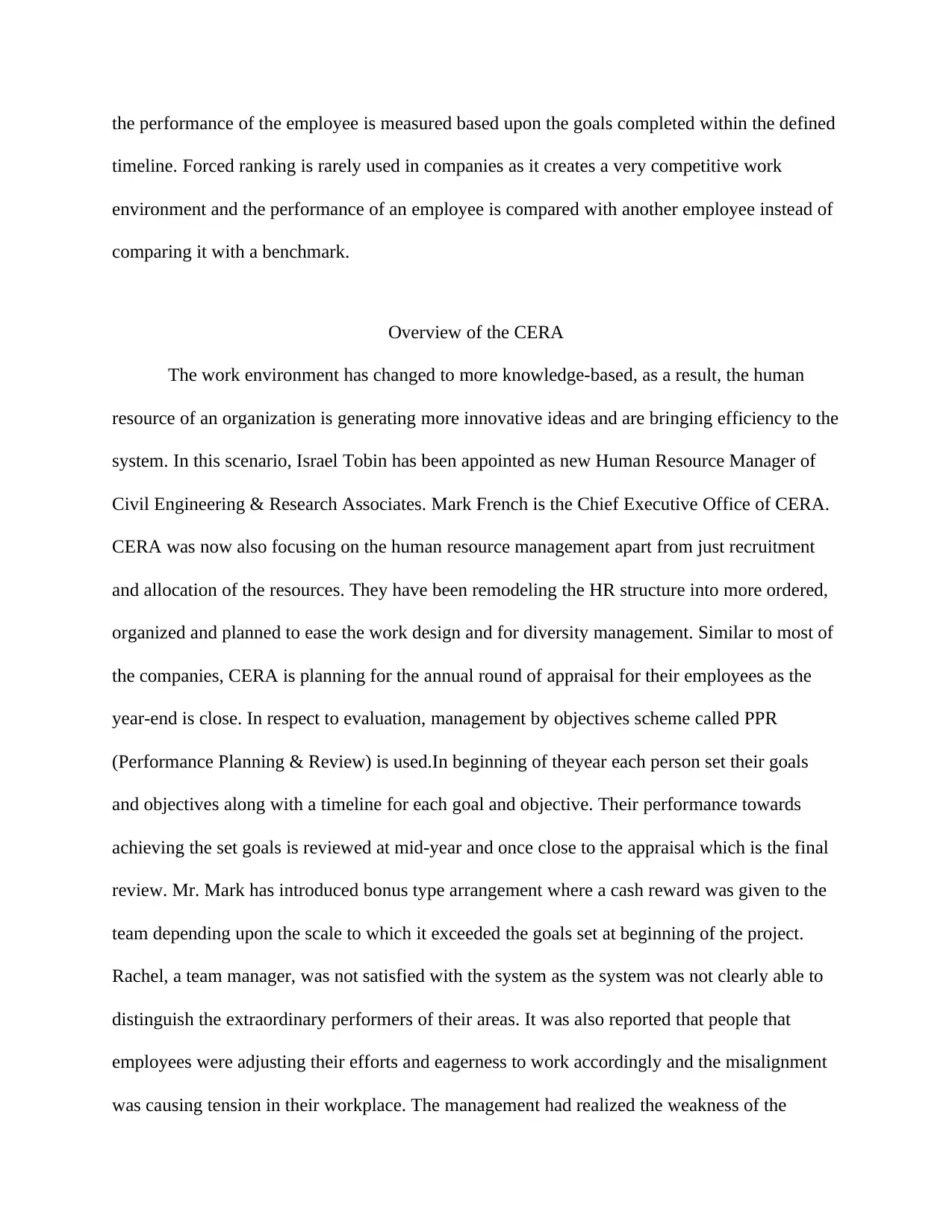
the performance of the employee is measured based upon the goals completed within the defined
timeline. Forced ranking is rarely used in companies as it creates a very competitive work
environment and the performance of an employee is compared with another employee instead of
comparing it with a benchmark.
Overview of the CERA
The work environment has changed to more knowledge-based, as a result, the human
resource of an organization is generating more innovative ideas and are bringing efficiency to the
system. In this scenario, Israel Tobin has been appointed as new Human Resource Manager of
Civil Engineering & Research Associates. Mark French is the Chief Executive Office of CERA.
CERA was now also focusing on the human resource management apart from just recruitment
and allocation of the resources. They have been remodeling the HR structure into more ordered,
organized and planned to ease the work design and for diversity management. Similar to most of
the companies, CERA is planning for the annual round of appraisal for their employees as the
year-end is close. In respect to evaluation, management by objectives scheme called PPR
(Performance Planning & Review) is used.In beginning of theyear each person set their goals
and objectives along with a timeline for each goal and objective. Their performance towards
achieving the set goals is reviewed at mid-year and once close to the appraisal which is the final
review. Mr. Mark has introduced bonus type arrangement where a cash reward was given to the
team depending upon the scale to which it exceeded the goals set at beginning of the project.
Rachel, a team manager, was not satisfied with the system as the system was not clearly able to
distinguish the extraordinary performers of their areas. It was also reported that people that
employees were adjusting their efforts and eagerness to work accordingly and the misalignment
was causing tension in their workplace. The management had realized the weakness of the
timeline. Forced ranking is rarely used in companies as it creates a very competitive work
environment and the performance of an employee is compared with another employee instead of
comparing it with a benchmark.
Overview of the CERA
The work environment has changed to more knowledge-based, as a result, the human
resource of an organization is generating more innovative ideas and are bringing efficiency to the
system. In this scenario, Israel Tobin has been appointed as new Human Resource Manager of
Civil Engineering & Research Associates. Mark French is the Chief Executive Office of CERA.
CERA was now also focusing on the human resource management apart from just recruitment
and allocation of the resources. They have been remodeling the HR structure into more ordered,
organized and planned to ease the work design and for diversity management. Similar to most of
the companies, CERA is planning for the annual round of appraisal for their employees as the
year-end is close. In respect to evaluation, management by objectives scheme called PPR
(Performance Planning & Review) is used.In beginning of theyear each person set their goals
and objectives along with a timeline for each goal and objective. Their performance towards
achieving the set goals is reviewed at mid-year and once close to the appraisal which is the final
review. Mr. Mark has introduced bonus type arrangement where a cash reward was given to the
team depending upon the scale to which it exceeded the goals set at beginning of the project.
Rachel, a team manager, was not satisfied with the system as the system was not clearly able to
distinguish the extraordinary performers of their areas. It was also reported that people that
employees were adjusting their efforts and eagerness to work accordingly and the misalignment
was causing tension in their workplace. The management had realized the weakness of the
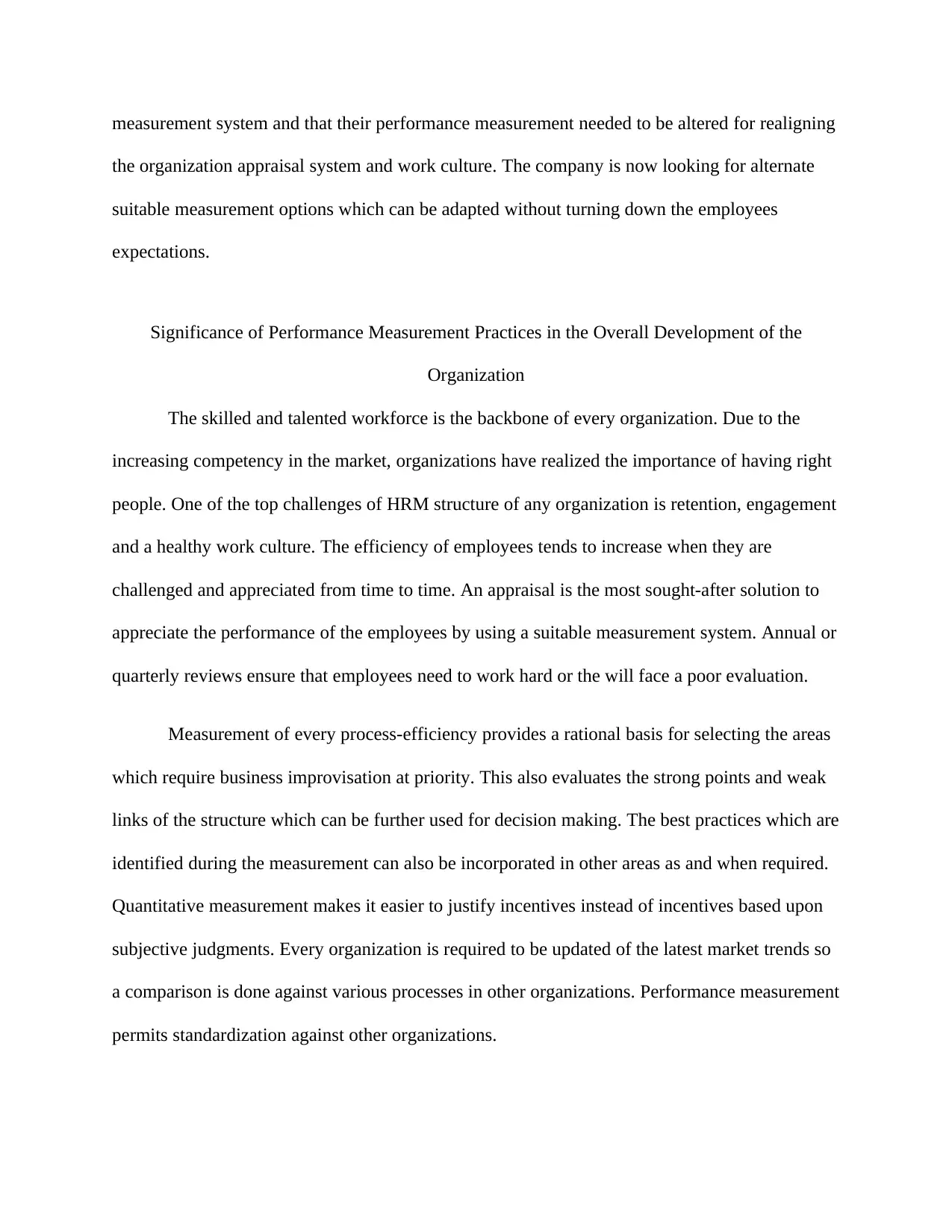
measurement system and that their performance measurement needed to be altered for realigning
the organization appraisal system and work culture. The company is now looking for alternate
suitable measurement options which can be adapted without turning down the employees
expectations.
Significance of Performance Measurement Practices in the Overall Development of the
Organization
The skilled and talented workforce is the backbone of every organization. Due to the
increasing competency in the market, organizations have realized the importance of having right
people. One of the top challenges of HRM structure of any organization is retention, engagement
and a healthy work culture. The efficiency of employees tends to increase when they are
challenged and appreciated from time to time. An appraisal is the most sought-after solution to
appreciate the performance of the employees by using a suitable measurement system. Annual or
quarterly reviews ensure that employees need to work hard or the will face a poor evaluation.
Measurement of every process-efficiency provides a rational basis for selecting the areas
which require business improvisation at priority. This also evaluates the strong points and weak
links of the structure which can be further used for decision making. The best practices which are
identified during the measurement can also be incorporated in other areas as and when required.
Quantitative measurement makes it easier to justify incentives instead of incentives based upon
subjective judgments. Every organization is required to be updated of the latest market trends so
a comparison is done against various processes in other organizations. Performance measurement
permits standardization against other organizations.
the organization appraisal system and work culture. The company is now looking for alternate
suitable measurement options which can be adapted without turning down the employees
expectations.
Significance of Performance Measurement Practices in the Overall Development of the
Organization
The skilled and talented workforce is the backbone of every organization. Due to the
increasing competency in the market, organizations have realized the importance of having right
people. One of the top challenges of HRM structure of any organization is retention, engagement
and a healthy work culture. The efficiency of employees tends to increase when they are
challenged and appreciated from time to time. An appraisal is the most sought-after solution to
appreciate the performance of the employees by using a suitable measurement system. Annual or
quarterly reviews ensure that employees need to work hard or the will face a poor evaluation.
Measurement of every process-efficiency provides a rational basis for selecting the areas
which require business improvisation at priority. This also evaluates the strong points and weak
links of the structure which can be further used for decision making. The best practices which are
identified during the measurement can also be incorporated in other areas as and when required.
Quantitative measurement makes it easier to justify incentives instead of incentives based upon
subjective judgments. Every organization is required to be updated of the latest market trends so
a comparison is done against various processes in other organizations. Performance measurement
permits standardization against other organizations.
⊘ This is a preview!⊘
Do you want full access?
Subscribe today to unlock all pages.

Trusted by 1+ million students worldwide
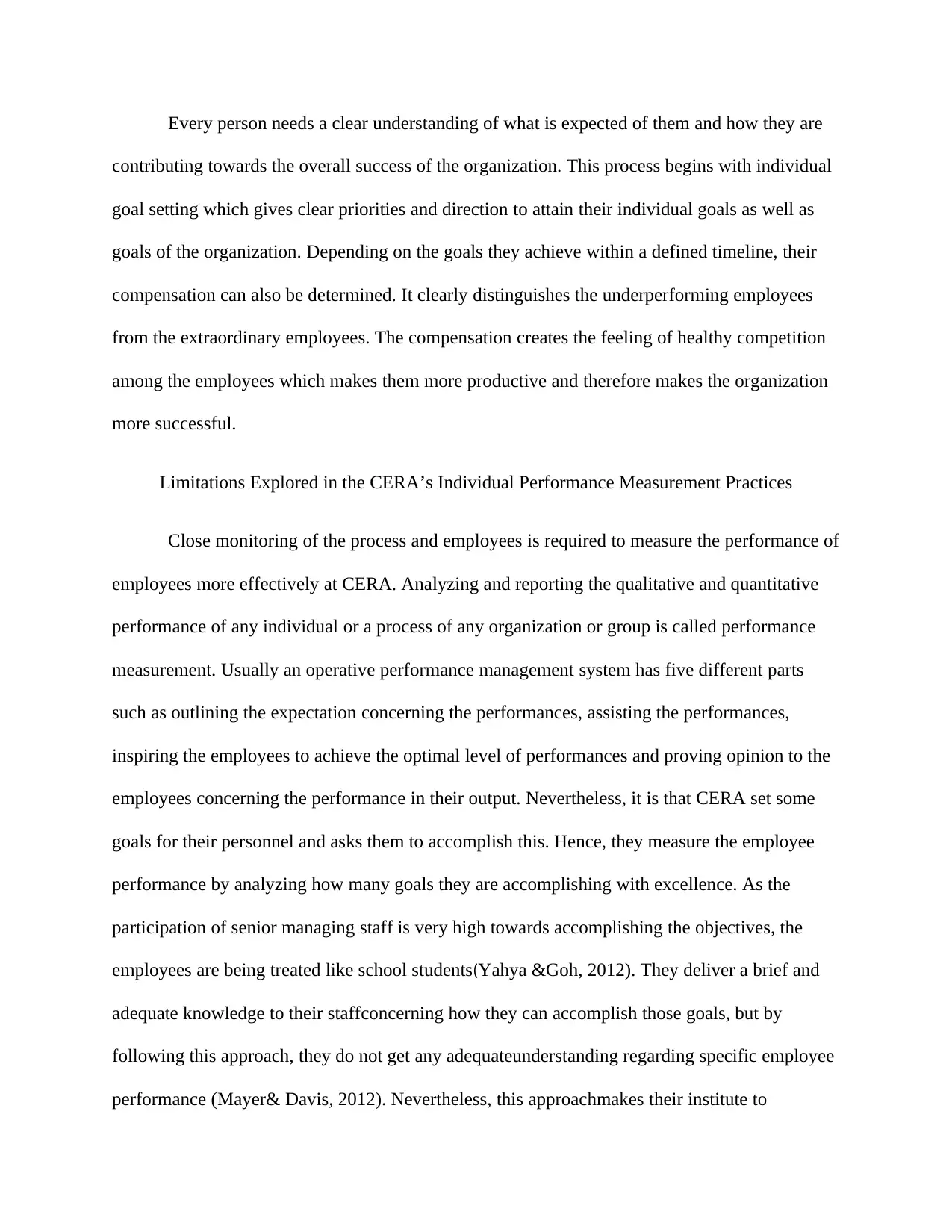
Every person needs a clear understanding of what is expected of them and how they are
contributing towards the overall success of the organization. This process begins with individual
goal setting which gives clear priorities and direction to attain their individual goals as well as
goals of the organization. Depending on the goals they achieve within a defined timeline, their
compensation can also be determined. It clearly distinguishes the underperforming employees
from the extraordinary employees. The compensation creates the feeling of healthy competition
among the employees which makes them more productive and therefore makes the organization
more successful.
Limitations Explored in the CERA’s Individual Performance Measurement Practices
Close monitoring of the process and employees is required to measure the performance of
employees more effectively at CERA. Analyzing and reporting the qualitative and quantitative
performance of any individual or a process of any organization or group is called performance
measurement. Usually an operative performance management system has five different parts
such as outlining the expectation concerning the performances, assisting the performances,
inspiring the employees to achieve the optimal level of performances and proving opinion to the
employees concerning the performance in their output. Nevertheless, it is that CERA set some
goals for their personnel and asks them to accomplish this. Hence, they measure the employee
performance by analyzing how many goals they are accomplishing with excellence. As the
participation of senior managing staff is very high towards accomplishing the objectives, the
employees are being treated like school students(Yahya &Goh, 2012). They deliver a brief and
adequate knowledge to their staffconcerning how they can accomplish those goals, but by
following this approach, they do not get any adequateunderstanding regarding specific employee
performance (Mayer& Davis, 2012). Nevertheless, this approachmakes their institute to
contributing towards the overall success of the organization. This process begins with individual
goal setting which gives clear priorities and direction to attain their individual goals as well as
goals of the organization. Depending on the goals they achieve within a defined timeline, their
compensation can also be determined. It clearly distinguishes the underperforming employees
from the extraordinary employees. The compensation creates the feeling of healthy competition
among the employees which makes them more productive and therefore makes the organization
more successful.
Limitations Explored in the CERA’s Individual Performance Measurement Practices
Close monitoring of the process and employees is required to measure the performance of
employees more effectively at CERA. Analyzing and reporting the qualitative and quantitative
performance of any individual or a process of any organization or group is called performance
measurement. Usually an operative performance management system has five different parts
such as outlining the expectation concerning the performances, assisting the performances,
inspiring the employees to achieve the optimal level of performances and proving opinion to the
employees concerning the performance in their output. Nevertheless, it is that CERA set some
goals for their personnel and asks them to accomplish this. Hence, they measure the employee
performance by analyzing how many goals they are accomplishing with excellence. As the
participation of senior managing staff is very high towards accomplishing the objectives, the
employees are being treated like school students(Yahya &Goh, 2012). They deliver a brief and
adequate knowledge to their staffconcerning how they can accomplish those goals, but by
following this approach, they do not get any adequateunderstanding regarding specific employee
performance (Mayer& Davis, 2012). Nevertheless, this approachmakes their institute to
Paraphrase This Document
Need a fresh take? Get an instant paraphrase of this document with our AI Paraphraser
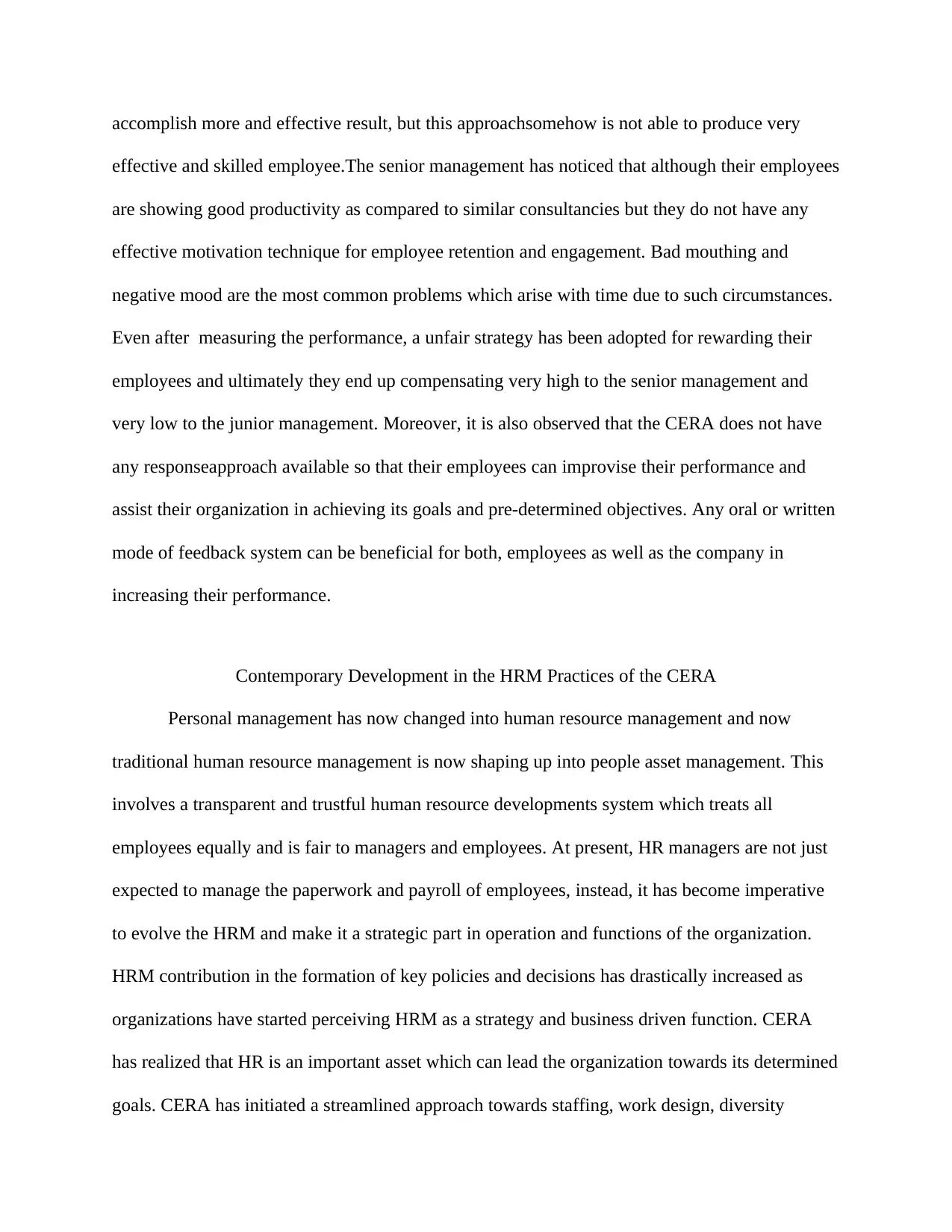
accomplish more and effective result, but this approachsomehow is not able to produce very
effective and skilled employee.The senior management has noticed that although their employees
are showing good productivity as compared to similar consultancies but they do not have any
effective motivation technique for employee retention and engagement. Bad mouthing and
negative mood are the most common problems which arise with time due to such circumstances.
Even after measuring the performance, a unfair strategy has been adopted for rewarding their
employees and ultimately they end up compensating very high to the senior management and
very low to the junior management. Moreover, it is also observed that the CERA does not have
any responseapproach available so that their employees can improvise their performance and
assist their organization in achieving its goals and pre-determined objectives. Any oral or written
mode of feedback system can be beneficial for both, employees as well as the company in
increasing their performance.
Contemporary Development in the HRM Practices of the CERA
Personal management has now changed into human resource management and now
traditional human resource management is now shaping up into people asset management. This
involves a transparent and trustful human resource developments system which treats all
employees equally and is fair to managers and employees. At present, HR managers are not just
expected to manage the paperwork and payroll of employees, instead, it has become imperative
to evolve the HRM and make it a strategic part in operation and functions of the organization.
HRM contribution in the formation of key policies and decisions has drastically increased as
organizations have started perceiving HRM as a strategy and business driven function. CERA
has realized that HR is an important asset which can lead the organization towards its determined
goals. CERA has initiated a streamlined approach towards staffing, work design, diversity
effective and skilled employee.The senior management has noticed that although their employees
are showing good productivity as compared to similar consultancies but they do not have any
effective motivation technique for employee retention and engagement. Bad mouthing and
negative mood are the most common problems which arise with time due to such circumstances.
Even after measuring the performance, a unfair strategy has been adopted for rewarding their
employees and ultimately they end up compensating very high to the senior management and
very low to the junior management. Moreover, it is also observed that the CERA does not have
any responseapproach available so that their employees can improvise their performance and
assist their organization in achieving its goals and pre-determined objectives. Any oral or written
mode of feedback system can be beneficial for both, employees as well as the company in
increasing their performance.
Contemporary Development in the HRM Practices of the CERA
Personal management has now changed into human resource management and now
traditional human resource management is now shaping up into people asset management. This
involves a transparent and trustful human resource developments system which treats all
employees equally and is fair to managers and employees. At present, HR managers are not just
expected to manage the paperwork and payroll of employees, instead, it has become imperative
to evolve the HRM and make it a strategic part in operation and functions of the organization.
HRM contribution in the formation of key policies and decisions has drastically increased as
organizations have started perceiving HRM as a strategy and business driven function. CERA
has realized that HR is an important asset which can lead the organization towards its determined
goals. CERA has initiated a streamlined approach towards staffing, work design, diversity
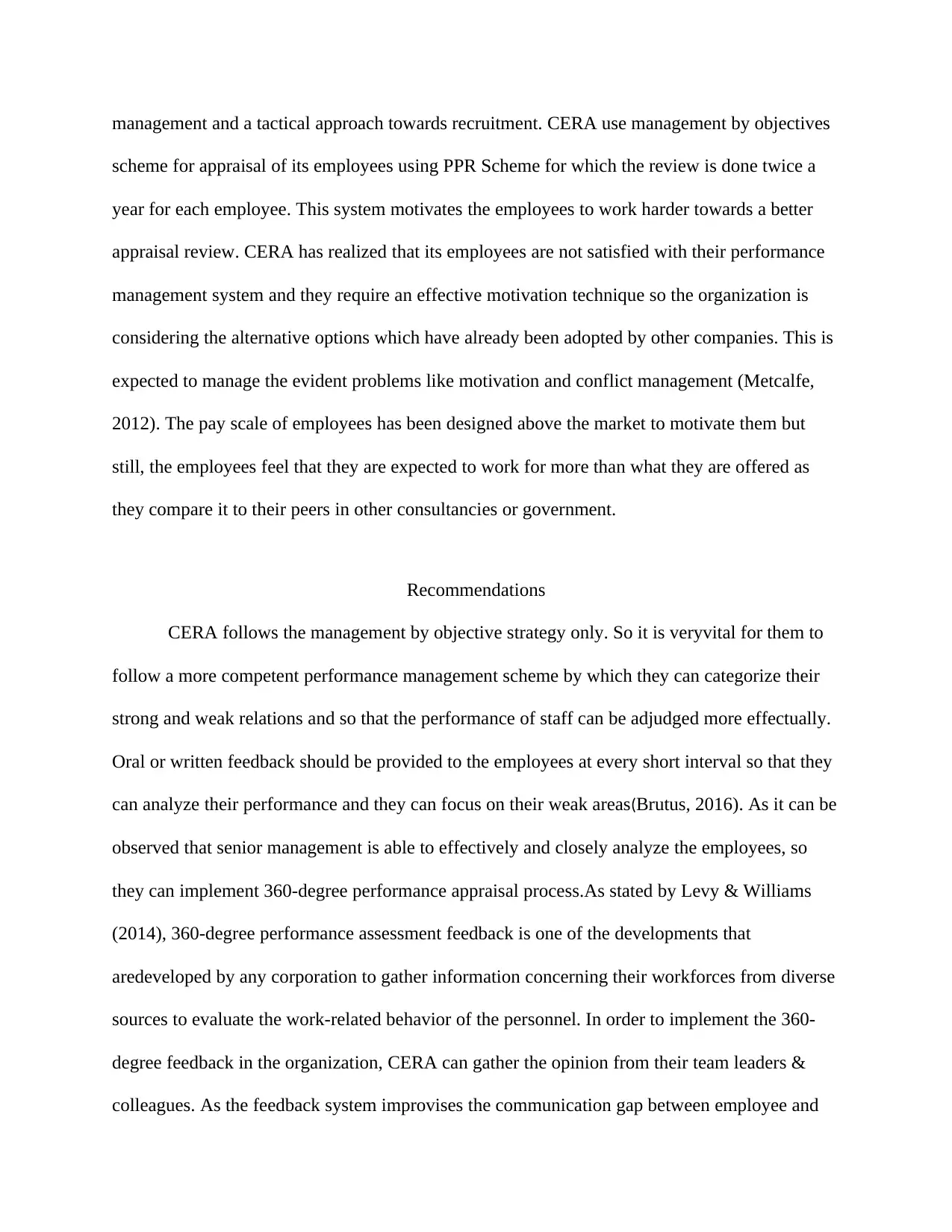
management and a tactical approach towards recruitment. CERA use management by objectives
scheme for appraisal of its employees using PPR Scheme for which the review is done twice a
year for each employee. This system motivates the employees to work harder towards a better
appraisal review. CERA has realized that its employees are not satisfied with their performance
management system and they require an effective motivation technique so the organization is
considering the alternative options which have already been adopted by other companies. This is
expected to manage the evident problems like motivation and conflict management (Metcalfe,
2012). The pay scale of employees has been designed above the market to motivate them but
still, the employees feel that they are expected to work for more than what they are offered as
they compare it to their peers in other consultancies or government.
Recommendations
CERA follows the management by objective strategy only. So it is veryvital for them to
follow a more competent performance management scheme by which they can categorize their
strong and weak relations and so that the performance of staff can be adjudged more effectually.
Oral or written feedback should be provided to the employees at every short interval so that they
can analyze their performance and they can focus on their weak areas(Brutus, 2016). As it can be
observed that senior management is able to effectively and closely analyze the employees, so
they can implement 360-degree performance appraisal process.As stated by Levy & Williams
(2014), 360-degree performance assessment feedback is one of the developments that
aredeveloped by any corporation to gather information concerning their workforces from diverse
sources to evaluate the work-related behavior of the personnel. In order to implement the 360-
degree feedback in the organization, CERA can gather the opinion from their team leaders &
colleagues. As the feedback system improvises the communication gap between employee and
scheme for appraisal of its employees using PPR Scheme for which the review is done twice a
year for each employee. This system motivates the employees to work harder towards a better
appraisal review. CERA has realized that its employees are not satisfied with their performance
management system and they require an effective motivation technique so the organization is
considering the alternative options which have already been adopted by other companies. This is
expected to manage the evident problems like motivation and conflict management (Metcalfe,
2012). The pay scale of employees has been designed above the market to motivate them but
still, the employees feel that they are expected to work for more than what they are offered as
they compare it to their peers in other consultancies or government.
Recommendations
CERA follows the management by objective strategy only. So it is veryvital for them to
follow a more competent performance management scheme by which they can categorize their
strong and weak relations and so that the performance of staff can be adjudged more effectually.
Oral or written feedback should be provided to the employees at every short interval so that they
can analyze their performance and they can focus on their weak areas(Brutus, 2016). As it can be
observed that senior management is able to effectively and closely analyze the employees, so
they can implement 360-degree performance appraisal process.As stated by Levy & Williams
(2014), 360-degree performance assessment feedback is one of the developments that
aredeveloped by any corporation to gather information concerning their workforces from diverse
sources to evaluate the work-related behavior of the personnel. In order to implement the 360-
degree feedback in the organization, CERA can gather the opinion from their team leaders &
colleagues. As the feedback system improvises the communication gap between employee and
⊘ This is a preview!⊘
Do you want full access?
Subscribe today to unlock all pages.

Trusted by 1+ million students worldwide
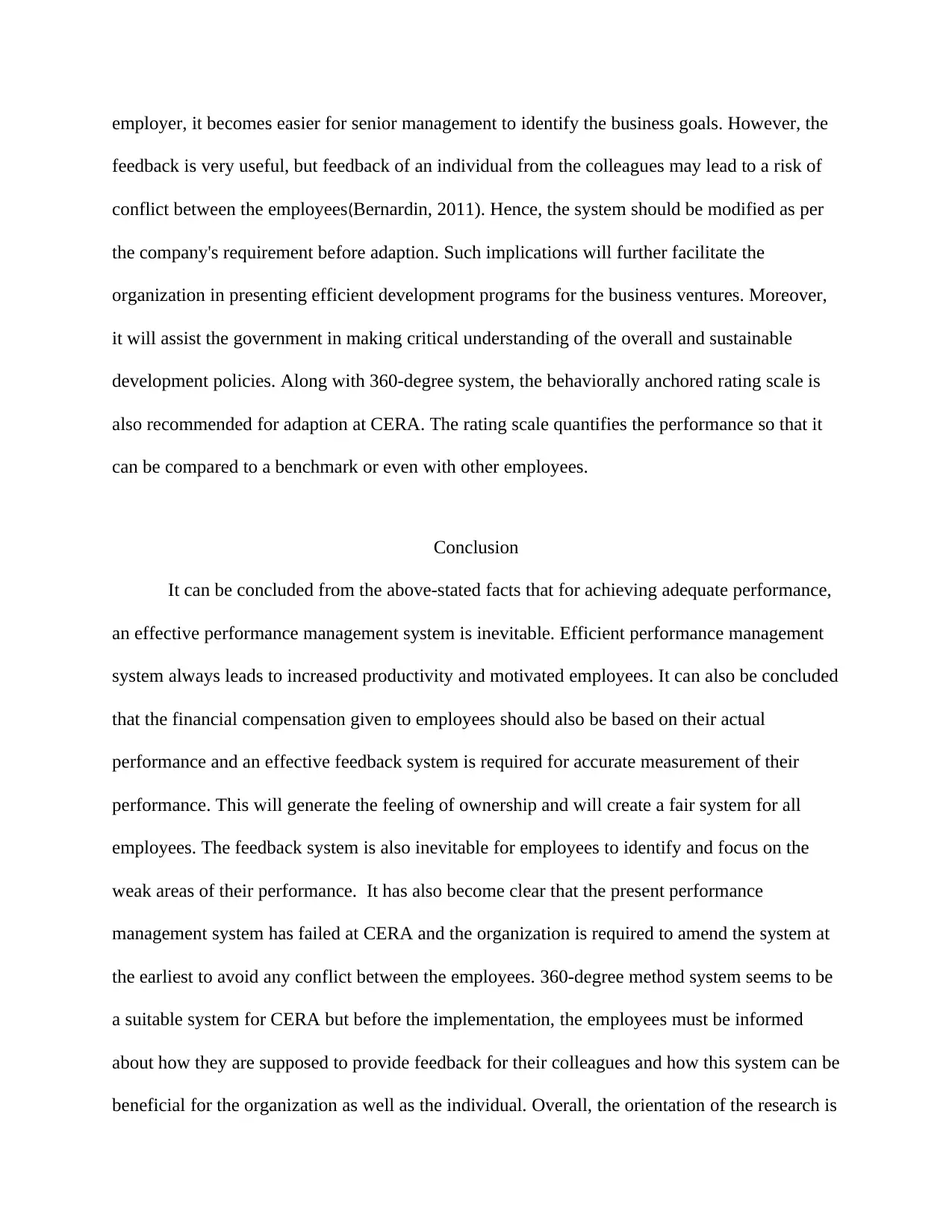
employer, it becomes easier for senior management to identify the business goals. However, the
feedback is very useful, but feedback of an individual from the colleagues may lead to a risk of
conflict between the employees(Bernardin, 2011). Hence, the system should be modified as per
the company's requirement before adaption. Such implications will further facilitate the
organization in presenting efficient development programs for the business ventures. Moreover,
it will assist the government in making critical understanding of the overall and sustainable
development policies. Along with 360-degree system, the behaviorally anchored rating scale is
also recommended for adaption at CERA. The rating scale quantifies the performance so that it
can be compared to a benchmark or even with other employees.
Conclusion
It can be concluded from the above-stated facts that for achieving adequate performance,
an effective performance management system is inevitable. Efficient performance management
system always leads to increased productivity and motivated employees. It can also be concluded
that the financial compensation given to employees should also be based on their actual
performance and an effective feedback system is required for accurate measurement of their
performance. This will generate the feeling of ownership and will create a fair system for all
employees. The feedback system is also inevitable for employees to identify and focus on the
weak areas of their performance. It has also become clear that the present performance
management system has failed at CERA and the organization is required to amend the system at
the earliest to avoid any conflict between the employees. 360-degree method system seems to be
a suitable system for CERA but before the implementation, the employees must be informed
about how they are supposed to provide feedback for their colleagues and how this system can be
beneficial for the organization as well as the individual. Overall, the orientation of the research is
feedback is very useful, but feedback of an individual from the colleagues may lead to a risk of
conflict between the employees(Bernardin, 2011). Hence, the system should be modified as per
the company's requirement before adaption. Such implications will further facilitate the
organization in presenting efficient development programs for the business ventures. Moreover,
it will assist the government in making critical understanding of the overall and sustainable
development policies. Along with 360-degree system, the behaviorally anchored rating scale is
also recommended for adaption at CERA. The rating scale quantifies the performance so that it
can be compared to a benchmark or even with other employees.
Conclusion
It can be concluded from the above-stated facts that for achieving adequate performance,
an effective performance management system is inevitable. Efficient performance management
system always leads to increased productivity and motivated employees. It can also be concluded
that the financial compensation given to employees should also be based on their actual
performance and an effective feedback system is required for accurate measurement of their
performance. This will generate the feeling of ownership and will create a fair system for all
employees. The feedback system is also inevitable for employees to identify and focus on the
weak areas of their performance. It has also become clear that the present performance
management system has failed at CERA and the organization is required to amend the system at
the earliest to avoid any conflict between the employees. 360-degree method system seems to be
a suitable system for CERA but before the implementation, the employees must be informed
about how they are supposed to provide feedback for their colleagues and how this system can be
beneficial for the organization as well as the individual. Overall, the orientation of the research is
Paraphrase This Document
Need a fresh take? Get an instant paraphrase of this document with our AI Paraphraser
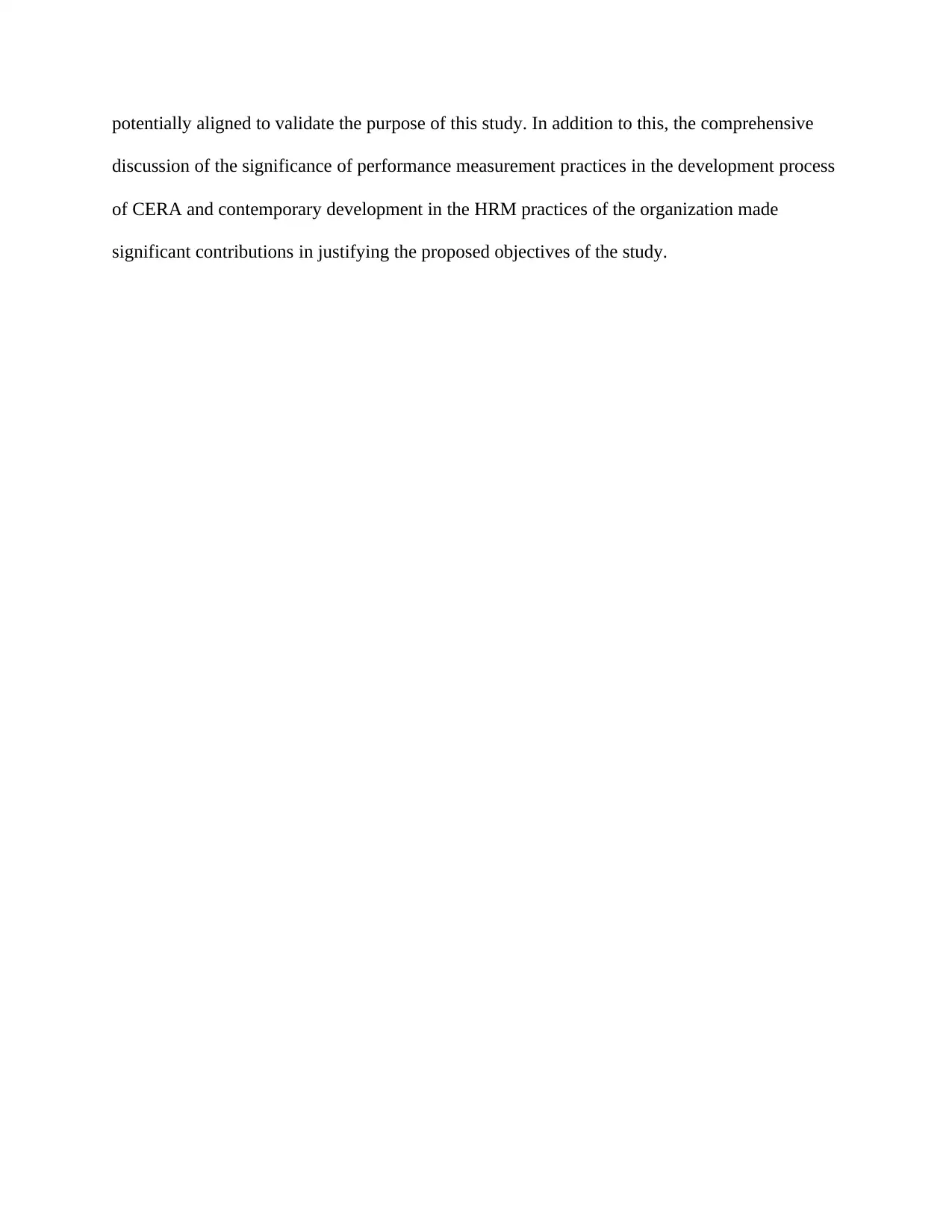
potentially aligned to validate the purpose of this study. In addition to this, the comprehensive
discussion of the significance of performance measurement practices in the development process
of CERA and contemporary development in the HRM practices of the organization made
significant contributions in justifying the proposed objectives of the study.
discussion of the significance of performance measurement practices in the development process
of CERA and contemporary development in the HRM practices of the organization made
significant contributions in justifying the proposed objectives of the study.
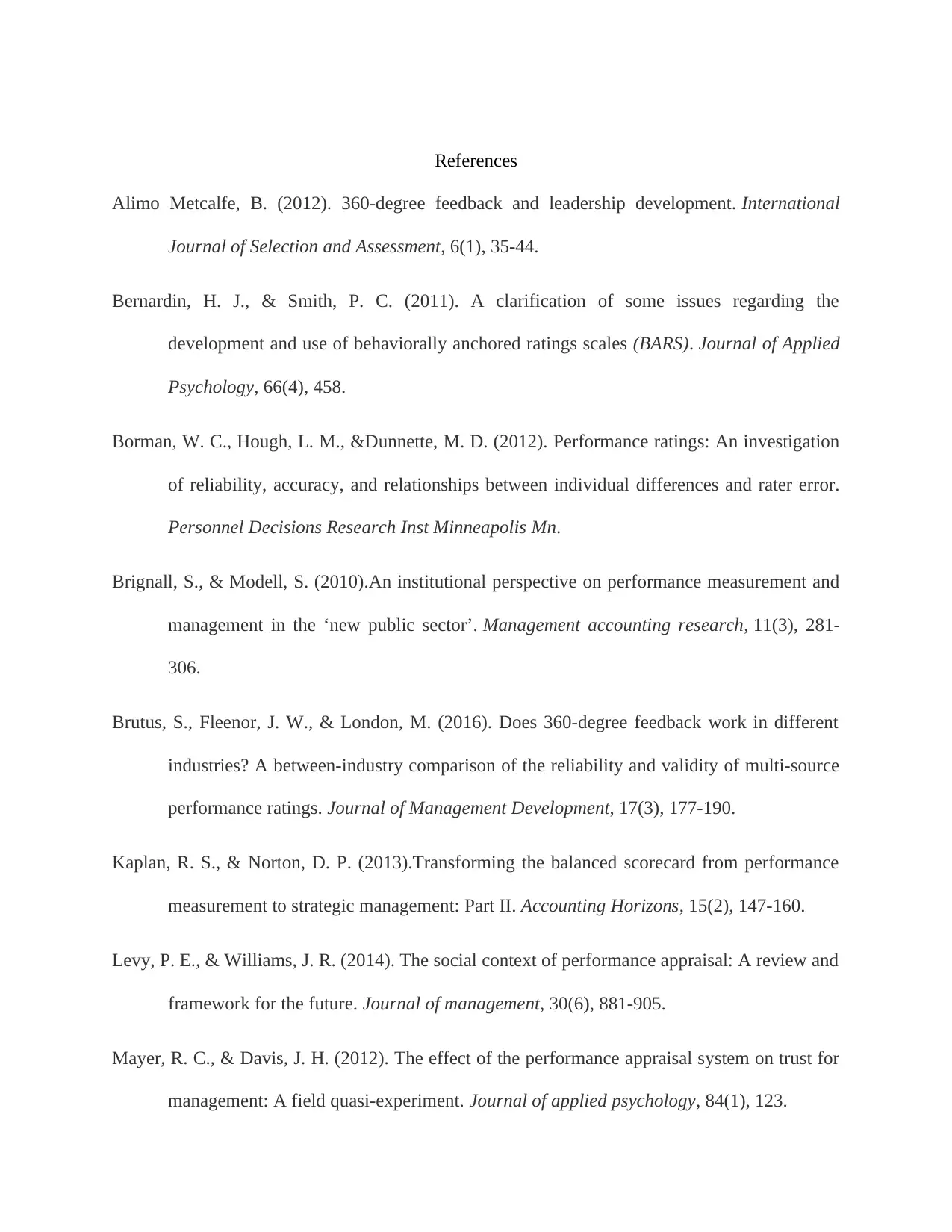
References
Alimo Metcalfe, B. (2012). 360-degree feedback and leadership development. International
Journal of Selection and Assessment, 6(1), 35-44.
Bernardin, H. J., & Smith, P. C. (2011). A clarification of some issues regarding the
development and use of behaviorally anchored ratings scales (BARS). Journal of Applied
Psychology, 66(4), 458.
Borman, W. C., Hough, L. M., &Dunnette, M. D. (2012). Performance ratings: An investigation
of reliability, accuracy, and relationships between individual differences and rater error.
Personnel Decisions Research Inst Minneapolis Mn.
Brignall, S., & Modell, S. (2010).An institutional perspective on performance measurement and
management in the ‘new public sector’. Management accounting research, 11(3), 281-
306.
Brutus, S., Fleenor, J. W., & London, M. (2016). Does 360-degree feedback work in different
industries? A between-industry comparison of the reliability and validity of multi-source
performance ratings. Journal of Management Development, 17(3), 177-190.
Kaplan, R. S., & Norton, D. P. (2013).Transforming the balanced scorecard from performance
measurement to strategic management: Part II. Accounting Horizons, 15(2), 147-160.
Levy, P. E., & Williams, J. R. (2014). The social context of performance appraisal: A review and
framework for the future. Journal of management, 30(6), 881-905.
Mayer, R. C., & Davis, J. H. (2012). The effect of the performance appraisal system on trust for
management: A field quasi-experiment. Journal of applied psychology, 84(1), 123.
Alimo Metcalfe, B. (2012). 360-degree feedback and leadership development. International
Journal of Selection and Assessment, 6(1), 35-44.
Bernardin, H. J., & Smith, P. C. (2011). A clarification of some issues regarding the
development and use of behaviorally anchored ratings scales (BARS). Journal of Applied
Psychology, 66(4), 458.
Borman, W. C., Hough, L. M., &Dunnette, M. D. (2012). Performance ratings: An investigation
of reliability, accuracy, and relationships between individual differences and rater error.
Personnel Decisions Research Inst Minneapolis Mn.
Brignall, S., & Modell, S. (2010).An institutional perspective on performance measurement and
management in the ‘new public sector’. Management accounting research, 11(3), 281-
306.
Brutus, S., Fleenor, J. W., & London, M. (2016). Does 360-degree feedback work in different
industries? A between-industry comparison of the reliability and validity of multi-source
performance ratings. Journal of Management Development, 17(3), 177-190.
Kaplan, R. S., & Norton, D. P. (2013).Transforming the balanced scorecard from performance
measurement to strategic management: Part II. Accounting Horizons, 15(2), 147-160.
Levy, P. E., & Williams, J. R. (2014). The social context of performance appraisal: A review and
framework for the future. Journal of management, 30(6), 881-905.
Mayer, R. C., & Davis, J. H. (2012). The effect of the performance appraisal system on trust for
management: A field quasi-experiment. Journal of applied psychology, 84(1), 123.
⊘ This is a preview!⊘
Do you want full access?
Subscribe today to unlock all pages.

Trusted by 1+ million students worldwide
1 out of 13
Related Documents
Your All-in-One AI-Powered Toolkit for Academic Success.
+13062052269
info@desklib.com
Available 24*7 on WhatsApp / Email
![[object Object]](/_next/static/media/star-bottom.7253800d.svg)
Unlock your academic potential
Copyright © 2020–2025 A2Z Services. All Rights Reserved. Developed and managed by ZUCOL.





